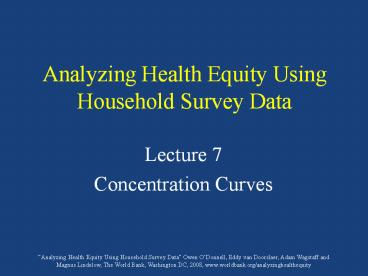Analyzing Health Equity Using Household Survey Data PowerPoint PPT Presentation
1 / 16
Title: Analyzing Health Equity Using Household Survey Data
1
Analyzing Health Equity Using Household Survey
Data
- Lecture 7
- Concentration Curves
2
How to measure health disparities?
- Measures of dispersion like the variance,
coefficient of variation, or Theils entropy
inform of total, not socioeconomic-related health
inequality - Relative risk ratios, e.g. mortality in top to
bottom occupation class, do not take account of
group sizes - Rate ratios of top to bottom quintiles do not
reflect the complete distribution - Borrow rank-dependent measuresLorenz curve and
Gini Indexand their bivariate extensionsconcentr
ation curve and indexfrom income distribution
literature and apply to socioeconomic-related
inequality in health variables
3
In which country are child deaths distributed
most unequally?
Comparison made difficult by differences in
levels. And have to rely on top versus bottom
relativities.
4
Comparison is easier using cumulative
distributions - Concentration curves
Child deaths are disproportionately concentrated
on the poor in both countries
But the disproportionate concentration
(inequality) appears greater in India
5
In general, concentration curve plots the
cumulative of health variable against the
cumulative of population ranked by
socioeconomic status
Must be possible to sum health variable. Living
standards variable only needs to provide a
ranking.
Curve above the diagonal ? concentration among
the poor Curve below the diagonal ?
concentration among the rich Curve on the
diagonal equality
6
Graphing concentration curves from grouped data
- Rank indvs/HHs by living standards variable, into
quintiles (or deciles) - Obtain for each quintile the mean of variable of
interest and relevant cases - Paste quintile means and counts into Excel form
cumulative relevant cases and corresponding
cumulative of total value of variable of
interest graph concentration curve using xy
chart
7
Under-five deaths in India
In excel
8
But the advantage of the concentration is that it
can be computed from individual level data and so
gives a picture of the complete distribution
Concentration Curve for Child Malnutrition in
Vietnam
glcurve neghaz, glvar(yord) pvar(rank)
sortvar(lnpcexp) replace by(year) split
lorenz or use twoway graph routines to plot the
co-ordinates yord rank
9
Assessing inequality in the standardized
distribution of health
- Concentration curve L(s) lies below diagonal ?
health is concentrated among the rich - L(s) is the indirectly standardized
concentration curve, i.e. the (unavoidable)
inequality to be expected on the basis of the
age-sex distribution - Inequality favoring the rich if L(s) lies below
L(s)
10
Concentration curve (Lorenz) dominance tests
- Concentration curve A dominates the 45o line
/Lorenz curve/conc. curve B if it lies above the
other line/curve - Comparing the point estimates of curves is not
sufficient to establish dominance - Concentration curves are estimated from survey
data and so display sampling variability - Need to conduct formal tests of significance of
difference between curves
11
Testing dominance b/w dependent curves
- Test significance of difference between ordinates
of curves at a number of quantiles - If the curves are independent, just requires the
standard errors for the point estimates of the
ordinates of each curve - But often the curves are dependent e.g. conc.
Lorenz curves, 2 conc. curves estimated from same
sample - Requires standard errors for the difference
between ordinates allowing for dependence - See Bishop, Chow Formby (IER, 1994) Davidson
Duclos (Econometrica, 1997)
12
Decision rule
- What constitutes a significant difference b/w two
curves? - At least one significant difference in one
direction and no significant difference in the
other? - This will over reject the null (for given
significance level) since are making multiple
comparisons - Can use same decision rule but correct critical
values (using Studentised Maximum Modulus) - Or require significant difference at all
quantiles compared (Intersection Union
Principle) - Dardanoni Forcina (Econometrics J. 1999) show
IUP is less likely to falsely reject null but has
much lower power to find dominance when exists
13
Tests can also find
- Non-dominance if no significant difference at any
quantile (with MCA rule) - Curves cross if at least one significant
difference in each direction
14
Number of comparison points
- If too few, not testing dominance across full
range of distribution - But always difficult to find significant
differences at extremes of curves - Common choice is to test at 19 evenly spaced
quantiles from 5 to 95
15
Stata ado for dominance testing
dominance varlist if in weight using
filename, sortvar() options Dominance of CC
against 45o line and Lorenz dominance totsub
awwght, sortvar(hhexp_eq) Dominance of one CC
against another dominance nonhsub ipsub
awwght, sortvar(hhexp_eq) Dominance of
independent CC use India dominance totsub
awweight using Vietnam, sortvar(hhexp_eq)
labels(India Vietnam)
16
Concentration curves for subsidies to inpatient
and non-hospital care in India

